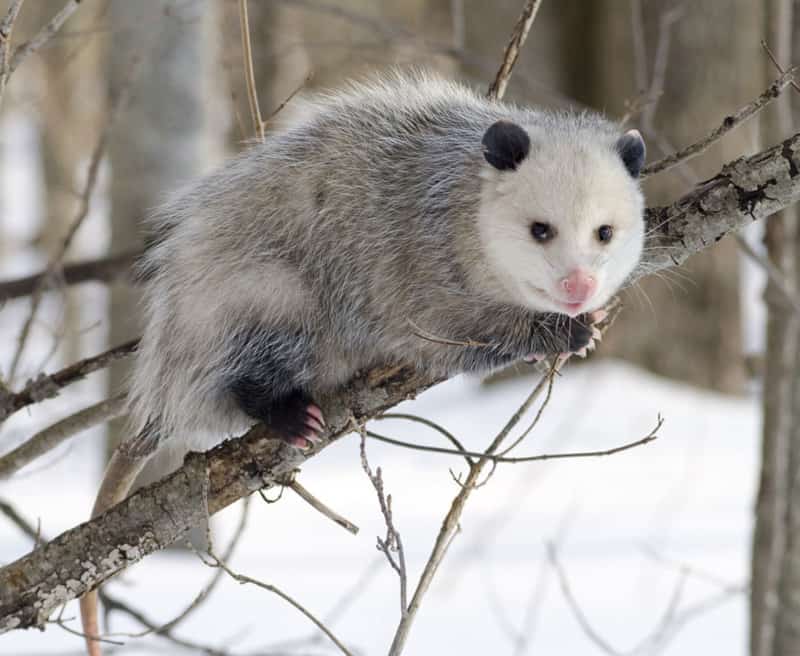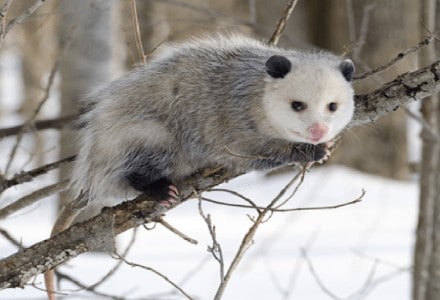
Opossum Facts
- Firstly, a total of 103 varieties of the animal known as the Opossum exist. The one pictured here represents the Virginia Opossum. It is native to the Virginia region of the United States, in North America.
- In addition, it also served as the first of the 103 species to be given the well-known common name. Further, the name itself came from the native language of the local Algonquin tribe of Native Americans.
- Moreover, the species has particularly unspecialized biology, flexible diet, and an impressive reproductive strategy. This makes it a successful colonizer and adapter to diverse locations and conditions.
- This particular Opossum also remains one of three mammals which share a highly unusual record. That’s because they share the record for the shortest gestation period on earth, numbering only 12 days.
Related Articles
Bandicoot Tree Kangaroo Quokka
Opossum Physical Description
Quite understandably, the various forms of Opossum display physical variations. However, many basic characteristics remain true to all of them. Only a few of them display a noticeable degree of sexual dimorphism.
Furthermore, the varying species vary significantly in size. That’s becasue they have a head and body length ranging from 4.7 – 37 in (12 – 94 cm). However, the majority of the different types grow to about the size of an average house cat.
Further, most of the differing species under the collective name display a narrow head with a long snout. The feet also have long, extremely powerful claws. In addition, the back feet of the animal each have one opposable digit.
Although coloring differs between them, each species has one other physical trait in common. Like many monkeys, the tail remains quite prehensile, serving the resourceful Opossum in a myriad of useful ways.
- Kingdom: Animalia
- Phylum: Chordata
- Class: Mammalia
- Order: Didelphimorphia
- Family: Didelphidae
Opossum Distribution, Habitat, and Ecology
Most notably, all known species classified as types of Opossum inhabit the Western Hemisphere. Obviously, however, the choice of habitats vary among the different species. Yet the great majority inhabit temperate forests.
While individuals often occupy an abandoned burrow from some other animal, most do not dig their own. Moreover, most appear nocturnal in nature. Most prefer dark, sturdy locations for a nest, either below or above ground.
In addition, the resourceful Opossum also developed a highly unique defense mechanism. This strategy it employs when either harmed or threatened. At such a time, an involuntary physiological response takes effect.
Also, the surprising creature loses consciousness, and its body subsequently becomes exceedingly stiff. After this, its lips curl back, saliva foams from the mouth, and an extremely foul-smelling fluid is secreted from a special gland.
The seemingly-deceased animal may be prodded, poked, and even moved without any sign of reaction. The enterprising animal literally looks, feels, and even smells to anyone encountering it as if it has been dead for some time.
This physiological condition isn’t short-lived, either. That’s because it typically lasts for between 40-240 minutes. After this time, the animal slowly regains consciousness, and eventually returns to its normal activities.
In addition, it feeds as an opportunistic omnivore with a very broad diet. Most primarily feed on carrion, but also eat frogs, insects, birds, snakes, small mammals, earthworms, and slugs. It also seems quite fond of various fruits. Finally, the animal usually lives a solitary and nomadic life in nature.
Species Sharing Its Range
Cobra Lily Florida Panther Luna Moth
Check out our other articles on 5 Rare Mind-Blowing Cloud Types, Dragon Moray Eel, Victoria amazonica, Green Sea Turtle, Berca Mud Volcanoes

